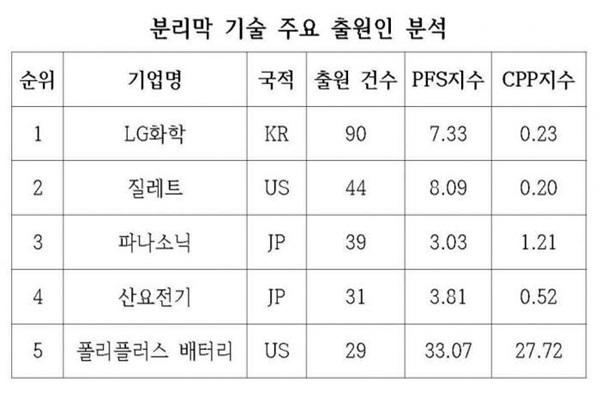Sodium batteries are receiving much attention as next generation’s secondary battery. According to ‘2014 Korea Patent Strategy Blueprint Report’ that was co-published by Korean Intellectual Property Office and Korea Intellectual Property Strategy Institute, secondary battery technology using sodium, which is more abundant and cheaper than lithium, was chosen as a promising technology in the future.
Advantages of lithium that is currently being used as main material for secondary battery are its small size and high energy density. But because it is such a scarce substance, it is inevitable that its price will continue to increase as amount of demand increases. Cost for battery needs to be greatly reduced if it were to be used as large-capacity storage battery for households.
This is why Sodium is getting much interest because its abundance is 6th highest in the world and it is much cheaper and easier to buy than lithium. According to the report, sodium battery can be used not only on large-sized energy storage system, but lithium ion battery as well for certain uses. It also announced that its cost can be reduced almost to 90% compared to lithium ion battery.
Fields within technologies concerning sodium secondary battery that attracts interests are separation film and poles. Separation film is a technology that protects electricity contact between poles by separating positive and negative poles. Poles are active negative polar substance development technologies that can smoothly harmonize sodium ion and battery anode development technology to apply on sodium secondary battery.
Looking at applications who applied for patents in separation film, LG Chem holds the most patents at 90, followed by Gillette with 44, followed by Panasonic with 39, and 31 and 29 patents for Sanyo Electric and Polyplus Battery respectively.

Looking at the result of evaluation of the relationship between technical influence and securing marketability by using major CPP (Cites Per Patent) and PFS (Patent Family Size), Polyplus Battery has the highest values in both CPP and PFS at 27.72 and 33.07 respectively.
Hitachi has the most patents in poles at 197, followed by LG Chem with 196. Sanyo Electric, NGK Insulators, and Panasonic have 159, 153, and 107 patents respectively.
LG Chem has the highest PFS value with 7.97, and Sanyo Electric and Panasonic have 3.42 and 3.10 respectively. Sanyo Electric has the highest CPP value with 1.46, followed by Panasonic with 1.26.
According to the report, anode manufacturing geomancy using carbon nanowire, carbon cathode active material manufacturing technology, and securing competitiveness and creating new intellectual property rights in porous coating layer technology were considered as possible technologies out of sodium secondary battery technologies.
*Detailed information can be found on IP Nomics’ homepage (www.ipnomics.co.kr)
■Analysis of major applicants in separation film technology
▲Ranking of applicants in order of number of patents in separation film
1. LG Chem (90, Korea), 2. Gillette (44, U.S.), 3. Panasonic (39, Japan), 4. Sanyo Electric (31, Japan), 5. Polyplus Battery (29, U.S.)
▲PFS values for major applications are LG Chem (7.33), Gillette (8.09), Panasonic (3.03), Sanyo Electric (3.81), and Polyplus Battery (33.07).
▲CPP values for major applications are LG Chem (0.23), Gillette (0.20), Panasonic (1.21), Sanyo Electric (0.52), and Polyplus Battery (27.72).
Staff Reporter Kim, Dal | kt@etnews.com